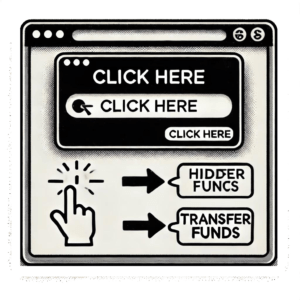Defining Clickjacking
Clickjacking is a sneaky trick that cyber criminals use to make you click on things you didn’t mean to. They hide links or buttons on websites so you accidentally click on them. This can result in sharing important information, giving permissions, or buying things without realizing it. Clickjacking usually involves putting invisible things on top of real website content to trick you into clicking on the wrong things.
Preventing clickjacking attacks is crucial for maintaining cybersecurity. Implementing measures such as using frame-busting scripts, ensuring proper header configurations, and employing content security policies can help mitigate the risk of clickjacking. It is essential for web developers and users alike to stay informed about clickjacking tactics and security best practices to safeguard against these deceptive attacks.
History and Evolution of Clickjacking
Clickjacking is a sneaky trick that hackers use to deceive people into clicking on things they didn’t intend to. This technique first appeared in the early 2000s, but became more common in the mid-2000s as social media and web apps became popular. As time has passed, clickjacking has become more advanced and poses a significant risk to online security.
Clickjacking attacks work by overlaying transparent elements on top of legitimate website content, making users unknowingly interact with hidden elements, such as clicking on malicious links or buttons. To prevent clickjacking attacks, users can employ measures such as using clickjacking protection headers, implementing frame-busting scripts, and staying vigilant against suspicious website behavior.
How Clickjacking Attacks Work
Clickjacking attacks, also referred to as UI redress attacks, are sneaky tricks used by cybercriminals to deceive users into clicking on hidden harmful elements on a website or app that looks real. The attacker puts these elements behind see-through layers, so users end up interacting with them without realizing it, thinking they’re engaging with the visible parts of the site.
To prevent clickjacking attacks, it is essential to implement measures like ensuring websites have X-Frame-Options headers set to deny, using frame-busting scripts to prevent site embedding, and regularly educating users on identifying and avoiding suspicious clicks. Additionally, web developers can employ UI design best practices to make it difficult for attackers to overlay content and manipulate user interactions.
By understanding how clickjacking attacks work and taking proactive steps to mitigate vulnerabilities, individuals and organizations can enhance their cybersecurity posture and protect against this deceiving form of cyber threat.
Real-World Examples of Clickjacking Attacks
Clickjacking attacks are a common method used by cybercriminals to deceive users into unknowingly clicking on malicious links or buttons. These attacks typically involve overlaying a transparent layer over a legitimate website, tricking users into interacting with the hidden content. One real-world example of a clickjacking attack is when a user thinks they are clicking on a harmless button to play a video, but in reality, they are clicking on a disguised “download” button that installs malware onto their device.
In order to avoid clickjacking attacks, users can take some steps to keep themselves safe. This includes using features like clickjacking protection headers, making sure to regularly update their software and web browsers, and being careful when clicking on any links or buttons that seem suspicious. By learning about how clickjacking attacks happen and staying aware of potential risks, users can best protect themselves from falling for these tricky tactics.
Impact of Clickjacking Attacks
Clickjacking attacks are a serious threat to user privacy. These attacks trick users into clicking on things they didn’t mean to on websites that appear safe. By hiding malicious commands in harmless-looking content, cybercriminals can manipulate users into giving away personal information or doing things they didn’t intend to do.
To prevent clickjacking attacks and safeguard user privacy, website administrators can implement defensive measures such as frame-busting scripts, X-Frame-Options headers, and Content Security Policy (CSP) directives. These security controls help mitigate the risk of clickjacking by restricting how a website can be embedded within a frame or iframe, thereby preventing malicious actors from overlaying deceptive elements onto the page.
Business and Reputation Damage
Clickjacking attacks are a serious threat to businesses because they can harm their reputation and finances. These attacks trick users into clicking on hidden harmful links or buttons that look like they are safe. When clicked, the attackers can access confidential information, control user sessions, or do things on the user’s behalf without them knowing.
To protect against clickjacking attacks, companies can take steps to improve security. This includes using X-Frame-Options headers to stop their websites from being placed into harmful iframes, setting up Content Security Policy (CSP) to manage which resources can be accessed on a webpage, and educating staff and customers on the dangers of clicking on questionable links or buttons.
Businesses can protect their reputation, keep sensitive information secure, and maintain trust with customers and stakeholders by being proactive about preventing clickjacking attacks.
Preventing Clickjacking Attacks
Best Practices for Users
Clickjacking attacks occur when bad people on the internet trick you into clicking on things that aren’t what they seem, leading you to unknowingly engage with harmful elements. This usually happens when invisible things are placed on top of real buttons or links, fooling you into doing something you didn’t want to do. To avoid such attacks, always be careful when clicking on links, especially if they’re from sources you don’t recognize. It’s also a good idea to keep your software and internet browser up-to-date with the latest security updates and take off auto-fill features on your browser. Using security add-ons can also help protect you from clickjacking. By keeping an eye out and following these tips, you can better protect yourself from these types of attacks.
Securing Websites Against Clickjacking
Clickjacking attacks, also known as UI redressing, involve tricking users into clicking on something different from what they see, often resulting in malicious actions or theft of sensitive information. Attackers usually hide harmful buttons or links under clickable content on legitimate websites. To protect against clickjacking, website owners can use frame-busting scripts to prevent their site from being targeted by attackers. It is also helpful to use X-Frame-Options HTTP headers to limit how a webpage can be framed, reducing the risk of clickjacking attacks. It’s important to regularly check for security issues, educate users on safe browsing practices, and stay updated on the latest attack methods to keep websites safe from clickjacking and ensure a secure online experience for visitors.
Reiteration and Summing up
Clickjacking attacks, also referred to as UI redressing, trick users into clicking on things they didn’t mean to. Attackers put fake content on top of real web pages to fool users into interacting with hidden elements without realizing it. To protect against Clickjacking attacks, website owners can take steps like setting up the X-Frame-Options HTTP headers to stop their pages from being used in iframes, adding scripts that break frames to stop their content from being framed, and making sure their user interfaces can’t be tricked with invisible overlays. It’s also important to keep browsers and plugins updated, use Content Security Policy headers, and regularly check for security issues to reduce the risk of Clickjacking attacks. Remember, staying alert and taking proactive steps is essential to keep your online activities safe from these clever cyber threats.
Clickjacking attacks are a serious online threat that can trick you into clicking on hidden buttons or links without your knowledge. These attacks involve placing harmful content on top of legitimate websites, so you interact with it by accident. This can lead to problems like your data being stolen, financial scams, or getting malware on your device.
To protect yourself from clickjacking, you can use security tools like frame-busting scripts, X-Frame-Options headers, and Content Security Policy (CSP) headers. It’s also important to learn how to spot and avoid clickjacking attempts. By being aware of these tricks and taking steps to prevent them, you can make sure your personal information stays safe online.
